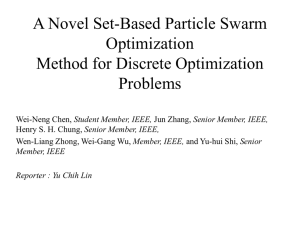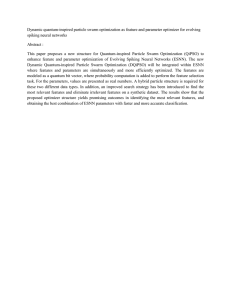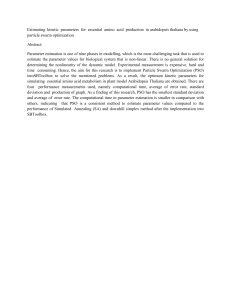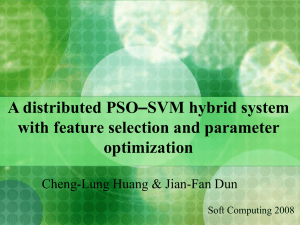Particle Swarm Optimization Method for Constrained Optimization
advertisement
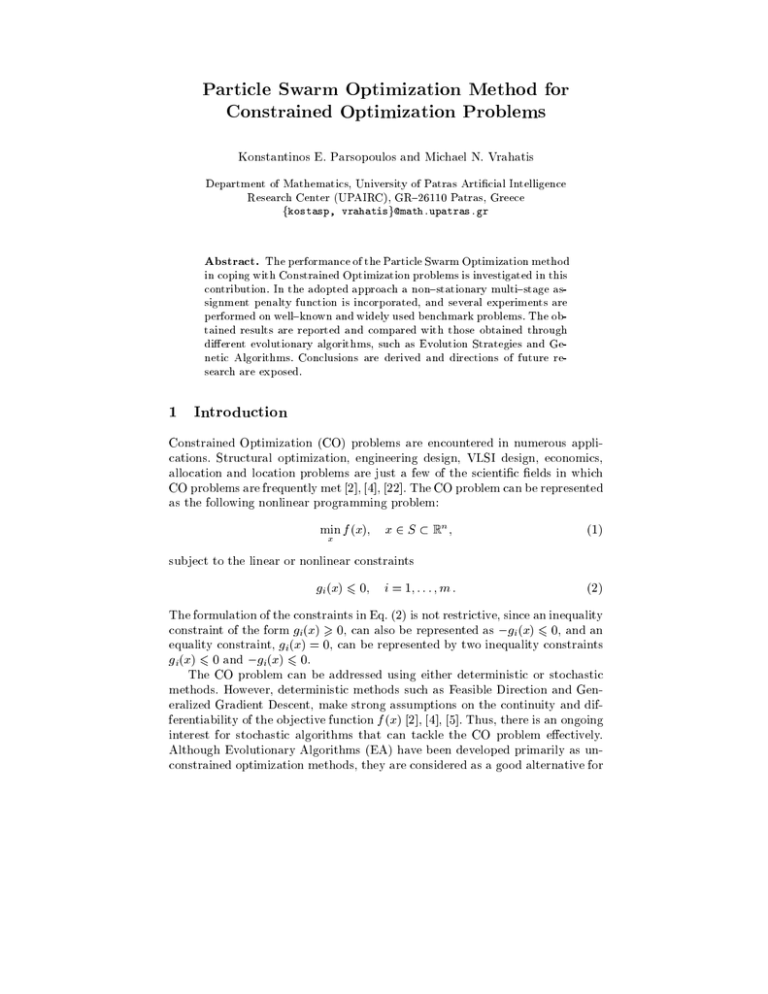
Particle Swarm Optimization Method for
Constrained Optimization Problems
Konstantinos E. Parsopoulos and Michael N. Vrahatis
Department of Mathematics, University of Patras Articial Intelligence
Research Center (UPAIRC), GR{26110 Patras, Greece
fkostasp, vrahatisg@math.upatras.gr
Abstract. The performance of the Particle Swarm Optimization method
in coping with Constrained Optimization problems is investigated in this
contribution. In the adopted approach a non{stationary multi{stage assignment penalty function is incorporated, and several experiments are
performed on well{known and widely used benchmark problems. The obtained results are reported and compared with those obtained through
dierent evolutionary algorithms, such as Evolution Strategies and Genetic Algorithms. Conclusions are derived and directions of future research are exposed.
1 Introduction
Constrained Optimization (CO) problems are encountered in numerous applications. Structural optimization, engineering design, VLSI design, economics,
allocation and location problems are just a few of the scientic elds in which
CO problems are frequently met [2], [4], [22]. The CO problem can be represented
as the following nonlinear programming problem:
min
f (x); x 2 S Rn ;
x
(1)
subject to the linear or nonlinear constraints
gi (x) 6 0; i = 1; : : : ; m :
(2)
The formulation of the constraints in Eq. (2) is not restrictive, since an inequality
constraint of the form gi (x) > 0, can also be represented as ;gi (x) 6 0, and an
equality constraint, gi (x) = 0, can be represented by two inequality constraints
gi (x) 6 0 and ;gi(x) 6 0.
The CO problem can be addressed using either deterministic or stochastic
methods. However, deterministic methods such as Feasible Direction and Generalized Gradient Descent, make strong assumptions on the continuity and differentiability of the objective function f (x) [2], [4], [5]. Thus, there is an ongoing
interest for stochastic algorithms that can tackle the CO problem eectively.
Although Evolutionary Algorithms (EA) have been developed primarily as unconstrained optimization methods, they are considered as a good alternative for
2
K.E. Parsopoulos and M.N. Vrahatis
solving CO problems. Promising results have been reported during the past few
years and several variants of Genetic Algorithms (GA) [6], Evolutionary Programming [3], and Evolution Strategies (ES) [20], have been proposed to cope
with the CO problem [7], [8], [12], [22].
The most common approach for solving CO problems is the use of a penalty
function. The constrained problem is transformed to an unconstrained one, by
penalizing the constraints and building a single objective function, which in
turn is minimized using an unconstrained optimization algorithm [2], [4], [19].
This is most probably the reason behind the popularity of the Penalty Function
approach when EAs are used to address the CO problem [8], [22].
In this paper, the performance of the Particle Swarm Optimization method
(PSO) [1], [11], in solving CO problems is investigated. The CO problem is
tackled through the minimization of a non{stationary multi{stage assignment
penalty function. The results of experiments performed on well{known test problems are reported and discussed in comparison with results obtained by other
EAs. In the next section, the Penalty Function approach is briey described. In
Section 3, the Particle Swarm Optimization method is presented, and, in Section
4, the test problems as well as the experimental results are reported. The paper
ends with conclusions and ideas for future research, reported in Section 5.
2 The Penalty Function Approach
The search space in CO problems consists of two kinds of points: feasible and
unfeasible. Feasible points satisfy all the constraints, while unfeasible points
violate at least one of them. The Penalty Function technique, solves the CO
problem through a sequence of unconstrained optimization problems [8]. Up to
date, no other method for dening pertinent penalty functions, than trial{and{
error, exists [22]. If the penalty values are high, the minimization algorithms
usually get trapped in local minima. On the other hand, if penalty values are
low, they can hardly detect feasible optimal solutions.
Penalty functions are distinguished into two main categories: stationary and
non{stationary. Stationary penalty functions, use xed penalty values throughout the minimization, while in contrast, in non{stationary penalty functions, the
penalty values are dynamically modied. In the literature, results obtained using
non{stationary penalty functions are almost always superior to those obtained
through stationary functions.
A penalty function is, generally, dened as [22]
F (x) = f (x) + h(k) H (x); x 2 S Rn ;
(3)
where f (x) is the original objective function of the CO problem in Eq. (1);
h(k) is a dynamically modied penalty value, where k is the algorithm's current
iteration number; and H (x) is a penalty factor, dened as
H (x) =
m
X
i=1
(qi (x)) qi (x) (q (x)) ;
i
(4)
PSO for Constrained Optimization Problems
3
where qi (x) = maxf0; gi(x)g, i = 1; : : : ; m. The function qi (x) is a relative
violated function of the constraints; (qi (x)) is a multi{stage assignment function [7]; (qi (x)) is the power of the penalty function; and gi (x) are the constraints described in Eq. (2).
The functions h(:), (:) and (:), are problem dependent. In our experiments,
a non{stationary multi{stage assignment penalty function was used. Details concerning the penalty function used in the experiments, are given in Section 4. In
the next section, the PSO algorithm is described.
3 The Particle Swarm Optimization Method
PSO is a stochastic global optimization method which is based on simulation of
social behavior. As in GA and ES, PSO exploits a population of potential solutions to probe the search space. In contrast to the aforementioned methods in
PSO no operators inspired by natural evolution are applied to extract a new generation of candidate solutions. Instead of mutation PSO relies on the exchange
of information between individuals, called particles, of the population, called
swarm. In eect, each particle adjusts its trajectory towards its own previous
best position, and towards the best previous position attained by any member
of its neighborhood [9]. In the global variant of PSO, the whole swarm is considered as the neighborhood. Thus, global sharing of information takes place and
particles prot from the discoveries and previous experience of all other companions during the search for promising regions of the landscape. To visualize the
operation of the method consider the case of the single{objective minimization
case; promising regions in this case possess lower function values compared to
others, visited previously.
Several variants of PSO have been proposed up to date, following Eberhart
and Kennedy who were the rst to introduce this method [1], [10], [11]. The
variants which were applied in our experiments are exposed in the following
paragraphs.
Initially, let us dene the notation adopted in this paper: assuming that the
search space is D{dimensional, the i-th particle of the swarm is represented by
a D{dimensional vector Xi = (xi1 ; xi2 ; : : : ; xiD ) and the best particle of the
swarm, i.e. the particle with the lowest function value, is denoted by index g.
The best previous position (i.e. the position corresponding to the best function
value) of the i-th particle is recorded and represented as Pi = (pi1 ; pi2 ; : : : ; piD ),
and the position change (velocity) of the i-th particle is Vi = (vi1 ; vi2 ; : : : ; viD ).
The particles are manipulated according to the following equations (the superscripts denote the iteration):
;
Vik+1 = wVik + c1 rik1 (Pik ; Xik ) + c2 rik2 (Pgk ; Xik ) ;
Xik+1 = Xik + Vik+1 ;
(5)
(6)
where i = 1; 2; : : :; N , and N is the size of the population; is a constriction
factor which is used to control and constrict velocities; w is the inertia weight;
4
K.E. Parsopoulos and M.N. Vrahatis
c1 and c2 are two positive constants, called the cognitive and social parameter
respectively; ri1 and ri2 are random numbers uniformly distributed within the
range [0; 1]. Eq. (5) is used to determine the i-th particle's new velocity, at each
iteration, while Eq. (6) provides the new position of the i-th particle, adding its
new velocity, to its current position. The performance of each particle is measured
according to a tness function, which is problem{dependent. In optimization
problems, the tness function is usually identical with the objective function
under consideration.
The role of the inertia weight w is considered important for the PSO's convergence behavior. The inertia weight is employed to control the impact of the
previous history of velocities on the current velocity. Thus, the parameter w regulates the trade{o between the global (wide{ranging) and the local (nearby)
exploration abilities of the swarm. A large inertia weight facilitates exploration
(searching new areas), while a small one tends to facilitate exploitation, i.e. ne{
tuning the current search area. A proper value for the inertia weight w provides
balance between the global and local exploration ability of the swarm, and, thus
results in better solutions. Experimental results imply that it is preferable to
initially set the inertia to a large value, to promote global exploration of the
search space, and gradually decrease it to obtain rened solutions [21]. The initial population can be generated either randomly or by using a Sobol sequence
generator [18], which ensures that the D-dimensional vectors will be uniformly
distributed within the search space.
The PSO technique has proven to be very ecient for solving real valued
global unconstrained optimization problems [13]{[17]. In the next section experimental results of the performance of PSO in CO problems are reported.
4 Experimental Results
The performance of three variants of PSO was investigated on well{known and
widely used test problems. One variant utilizes only inertia weight (denoted as
PSO-In), a second variant utilizes only constriction factor (denoted as PSO-Co),
and the last one utilizes both inertia weight and constriction factor (denoted
as PSO-Bo). For all variants, xed values, considered as default, for the PSO's
parameters were used: c1 = c2 = 2; w was gradually decreased from 1.2 towards
0.1; = 0:73. Some variants of PSO, impose a maximum value on the velocity,
Vmax , to prevent the swarm from explosion. In our experiments Vmax was always
xed, to the value of Vmax = 4. The size of the swarm was set equal to 100, 10
runs were performed for each test problem, and the PSO algorithm ran for 1000
iterations, in each case. A violation tolerance was used for the constraints. Thus,
a constraint gi (x) was assumed to be violated, only if gi (x) > 10;5.
Regarding the penalty parameters, the same values as the values reported
in [22] were used, to obtain results comparable to the results obtained using
dierent EA, in [22]. Specically, if qi (x) < 1, then (qi (x)) = 1, otherwise
(qi (x)) = 2. Moreover, if qi (x) < 0:001 then (qi (x)) = 10, else, if qi (x) 6 0:1
then (qi (x)) = 20, else, if qi (x) 6 1 then (qi (x)) = 100, otherwise (qi (x)) =
PSO for Constrained Optimization Problems
p
5
300. Regarding
p the function h(:), it was set to h(k) = k for Test Problem 1,
and h(k) = k k for the rest problems.
The test problems are dened immediately below:
Test Problem 1, [4]:
f (x) = (x1 ; 2)2 + (x2 ; 1)2 ;
subject to x1 = 2x2 ; 1; x21 =4 + x22 ; 1 6 0. The best known solution is f =
1:3934651.
Test Problem 2, [2]:
f (x) = (x1 ; 10)3 + (x2 ; 20)3;
subject to 100 ; (x1 ; 5)2 ; (x2 ; 5)2 6 0; (x1 ; 6)2 +(x2 ; 5)2 ; 82:81 6 0; 13 6
x1 6 100; 0 6 x2 6 100. The best known solution is f = ;6961:81381.
Test Problem 3, [5]:
f (x) = (x1 ; 10)2 + 5(x2 ; 12)2 + x43 + 3(x4 ; 11)2 +
+10x65 + 7x26 + x47 ; 4x6 x7 ; 10x6 ; 8x7 ;
subject to ;127+2x21+3x42 +x3 +4x24 +5x5 6 0; ;282+7x1+3x2 +10x23+x4 ;x5 6
0; ;196 + 23x1 + x22 + 6x26 ; 8x7 6 0; 4x21 + x22 ; 3x1 x2 + 2x23 + 5x6 ; 11x7 6
0; ;10 6 xi 6 10; i = 1; : : : ; 7. The best known solution is f = 680:630057.
Test Problems 4 and 5 , [5]:
f (x) = 5:3578547x23 + 0:8356891x1x5 + 37:293239x1 ; 40792:141;
subject to 0 6 85:334407 + 0:0056858T1 + T2 x1 x4 ; 0:0022053x3x5 6 92; 90 6
80:51249+0:0071317x2x5 +0:0029955x1x2 +0:0021813x23 6 110; 20 6 9:300961+
0:0047026x3x5 + 0:0012547x1x3 + 0:0019085x3x4 6 25; 78 6 x1 6 102; 33 6
x2 6 45; 27 6 xi 6 45; i = 3; 4; 5, where T1 = x2 x5 and T2 = 0:0006262 for Test
Problem 4, and T1 = x2 x3 , T2 = 0:00026 for Test Problem 5. The best known
solution for Test Problem 4 is f = ;30665:538, while for Test Problem 5 it is
unknown.
Test Problem 6, [12]:
f (x; y) = ;10:5x1 ; 7:5x2 ; 3:5x3 ; 2:5x4 ; 1:5x5 ; 10y ; 0:5
5
X
i=1
x2i ;
subject to 6x1 +3x2 +3x3 +2x4 + x5 ; 6:5 6 0, 10x1 +10x3 + y 6 20, 0 6 xi 6 1,
i = 1; : : : ; 5, 0 6 y. The best known solution is f = ;213:0.
For each test problem, the mean and the best solution obtained in all 10
runs, as well as the corresponding sum of violated constraints, were recorded. The
6
K.E. Parsopoulos and M.N. Vrahatis
Table 1. The mean and the best solution found in all 10 runs, for each method and
problem. The standard deviation of the optimal values for the 10 runs is reported. In
the parentheses the corresponding sums of violated constraints are reported
Problem Method Mean Solution (Sum V.C.)
PSO-In
1.394006 (0.000014)
1
PSO-Co
1.393431 (0.000020)
PSO-Bo
1.393431 (0.000020)
PSO-In -6960.866 (0.0000037)
2
PSO-Co -6961.836 (0.000019)
PSO-Bo -6961.774 (0.000013)
PSO-In
680.671 (0.000008)
3
PSO-Co
680.663 (0.00034)
PSO-Bo
680.683 (0.000015)
PSO-In
-31526.304 (1.297)
4
PSO-Co
-31528.289 (1.326)
PSO-Bo
-31493.190 (1.331)
PSO-In
-31523.859 (0.958)
5
PSO-Co
-31526.308 (0.965)
PSO-Bo
-31525.492 (0.968)
PSO-In
-213.0 (0.0)
6
PSO-Co
-213.0 (0.0)
PSO-Bo
-213.0 (0.0)
St.D. Best Solution (Sum V.C.)
0.0015 1.393431 (0.000020)
0.0
1.393431 (0.000020)
0.0
1.393431 (0.000020)
0.608 -6961.798 (0.0000087)
0.0011 -6961.837 (0.000019)
0.14
-6961.837 (0.000019)
0.034
680.639 (0.000019)
0.050
680.635 (0.00130)
0.041
680.636 (0.0)
18.037
-31543.484 (1.311)
12.147
-31542.578 (1.311)
131.67
-31544.459 (1.311)
17.531
-31544.036 (0.997)
19.153
-31543.312 (0.996)
23.392
-31545.054 (0.999)
0.0
-213.0 (0.0)
0.0
-213.0 (0.0)
0.0
-213.0 (0.0)
results for all test problems are reported in Table 1. In all test problems, the three
variants of PSO exhibited similar results. In most cases PSO outperformed the
results reported in [22] for other EA. Proper ne{tuning of the PSO's parameters
may result in better solutions.
5 Conclusions and Further Work
The capability of the PSO method to address CO problems was investigated
through the performance of numerous experiments on well{known and widely
used test problems. Preliminary results, obtained through the use of a non{
stationary multi{stage penalty function, imply that PSO is a good alternative
for tackling CO problems. In most cases PSO detected superior solutions than
those obtained through other EAs, as reported in [22]. It should be mentioned
that the results were competitive in all cases, despite the fact that only the
default parameters of PSO were considered. The performance of the three PSO's
variants was similar for all test problems.
Future work will include investigation of the PSO's performance in other
benchmark and real{life problems, as well as the development of specialized
operators that will indirectly enforce feasibility of the particles and guide the
swarm towards the optimum solution, as well as ne{tuning of the parameters
that may result in better solutions.
PSO for Constrained Optimization Problems
7
References
1. Eberhart, R.C., Simpson, P.K., Dobbins, R.W.: Computational Intelligence PC
Tools. Academic Press Professional, Boston (1996)
2. Floudas, C.A., Pardalos, P.M.: A Collection of Test Problems for Constrained Global
Optimization Algorithms. Lecture Notes in Computer Science, Vol. 455. SpringerVerlag, Berlin Heidelberg New York (1987)
3. Fogel, D.B.: An Introduction to Simulated Evolutionary Optimization. IEEE Trans.
Neural Networks 5(1) (1994) 3{14
4. Himmelblau, D.M.: Applied Nonlinear Programming. McGraw{Hill (1972)
5. Hock, W., Schittkowski, K.: Test Examples for Nonlinear Programming Codes. Lecture Notes in Economics and Mathematical Systems, Vol. 187. Springer-Verlag,
Berlin Heidelberg New York (1981)
6. Holland, J.H.: Adaptation in Natural and Articial Systems. MIT Press (1992)
7. Homaifar, A., Lai, A.H.{Y., Qi, X.: Constrained Optimization via Genetic Algorithms. Simulation 2(4) (1994) 242{254
8. Joines, J.A., Houck, C.R.: On the Use of Non{Stationary Penalty Functions to Solve
Nonlinear Constrained Optimization Problems with GA's. Proc. IEEE Int. Conf.
Evol. Comp. (1994) 579{585
9. Kennedy, J.: The Behavior of Particles. Evol. Progr. VII (1998) 581{587
10. Kennedy, J., Eberhart, R.C.: Particle Swarm Optimization. Proc. IEEE Int. Conf.
Neural Networks. Piscataway, NJ (1995) 1942{1948
11. Kennedy, J., Eberhart, R.C.: Swarm Intelligence. Morgan Kaufmann (2001)
12. Michalewicz, Z.: Genetic Algorithms + Data Structures = Evolution Programs.
Springer{Verlag, New York (1992)
13. Parsopoulos, K.E., Plagianakos, V.P., Magoulas, G.D., Vrahatis, M.N.: Objective
Function \Stretching" to Alleviate Convergence to Local Minima. Nonlinear Analysis TMA 47(5) (2001) 3419{3424
14. Parsopoulos, K.E., Plagianakos, V.P., Magoulas, G.D., Vrahatis, M.N.: Stretching
Technique for Obtaining Global Minimizers Through Particle Swarm Optimization.
Proc. Particle Swarm Optimization Workshop. Indianapolis (IN), USA (2001) 22{29
15. Parsopoulos, K.E., Vrahatis, M.N.: Modication of the Particle Swarm Optimizer
for Locating All the Global Minima. V. Kurkova, N. Steele, R. Neruda, M. Karny
(eds.), Articial Neural Networks and Genetic Algorithms. Springer, Wien (Computer Science Series) (2001) 324{327
16. Parsopoulos, K.E., Laskari, E.C., Vrahatis, M.N.: Solving `1 Norm Errors-InVariables Problems Using Particle Swarm Optimizer. M.H. Hamza (ed.), Articial
Intelligence and Applications. IASTED/ACTA Press (2001) 185{190
17. Parsopoulos, K.E., Vrahatis, M.N.: Initializing the Particle Swarm Optimizer Using the Nonlinear Simplex Method. A. Grmela, N.E. Mastorakis (eds.), Advances
in Intelligent Systems, Fuzzy Systems, Evolutionary Computation. WSEAS Press
(2002) 216{221
18. Press, W.H., Vetterling, W.T., Teukolsky, S.A., Flannery, B.P.: Numerical Recipes
in Fortran 77. Cambridge University Press, Cambridge (1992)
19. Rao, S.S.: Optimization: Theory and Applications. Wiley Eastern Limited (1977)
20. Schwefel, H.{P.: Evolution and Optimum Seeking. Wiley (1995)
21. Shi, Y., Eberhart, R.C.: Parameter Selection in Particle Swarm Optimization. Evolutionary Programming VII (1998) 591{600
22. Yang, J.{M., Chen, Y.{P., Horng, J.{T., Kao, C.{Y.: Applying Family Competition
to Evolution Strategies for Constrained Optimization. Lecture Notes in Computer
Science, Vol. 1213. Springer-Verlag, Berlin Heidelberg New York (1997) 201{211


